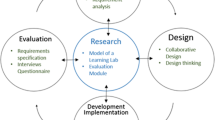Abstract
A Transdisciplinary Living Lab Model (TDLL) was developed in collaboration with two Australian Universities: the University of Technology Sydney and Western Sydney University. This TDLL model takes a transdisciplinary approach to learning while utilizing the university campus as a living laboratory. This chapter presents the processes used to create, and discusses the benefits of creating, a conducive environment for transdisciplinary learning on-campus in a project-based living lab.
Access this chapter
Tax calculation will be finalised at checkout
Purchases are for personal use only
Similar content being viewed by others
Notes
- 1.
- 2.
- 3.
- 4.
- 5.
http://www.un.org/sustainabledevelopment/sustainable-consumption-production/ (accessed 28/08/2017).
- 6.
References
Abson D, Fischer J, Leventon J, Newig J, Schomerus T, Vilsmaier U, von Wehrden H, Abernethy P, Ives CD; Jager NW, Lang DJ (2017) Leverage points for sustainability transformation. Ambio 46:30–39
Brown VA (2010) Collective inquiry and its wicked problems. In: Brown VA, Harris JA, Russell JY (eds) Tackling Wicked Problems through the transdisciplinary imagination. Earthscan, London, pp 61–83
Capra F (1996) Web of life. Harper Collins, London
Curtis S (2015) An investigation of living labs for sustainability. Reflections on the living lab methodology. http://www.stevenkanecurtis.com/uploads/6/0/5/0/6050171/steven_c_arscp_a2_0308.pdf. Accessed 6th Dec 2017
Daniel A (2017) Strategic opportunities for sustainability-focused living laboratories at Western Sydney University. Western Sydney University. December, 2017 (in press)
Dewey J (1938) Experience and education. Collier, New York
Dutilleul B, Birrer FA, Mensink W (2010) Unpacking European living labs: analysing innovation’s social dimensions. Cent Eur J Public Policy 4(1):60–85
Fam D, Leimbach T, Kelly S, Hitchens L Callen M (2018) Meta-considerations for planning, introducing and standardising interdisciplinary learning in higher degree institutions, In: Fam D, Neuhauser L, Gibbs P (eds) (2018) The art of collaborative research and collective learning: Transdisciplinary theory, practice and education. Springer, Dorschet
Fam DM, Mellick Lopes A (2015) Toilet practices and system change: lessons from a transdisciplinary research project. J Des Res 13(3):307–322
Fam DM, Smith T, Cordell D (2017) Being a transdisciplinary researcher: skills and dispositions fostering competence in transdisciplinary research and practice. In: Fam D, Palmer J, Riedy C, Mitchell C (eds) Transdisciplinary research and practice for sustainability outcomes, Routledge
Fry T (2009) Design futuring: sustainability, ethics and new practice. Oxford, Berg
Graczyk G (2015) Embedding a living lab approach at the University of Edinburgh. The University of Edinburgh. https://www.ed.ac.uk/files/atoms/files/embedding_a_living_lab_approach_at_the_university_of_edinburgh.pdf. Last accessed, 12th Mar 2018
Hoffman A, Axson J (2017) Examining interdisciplinary sustainability institutes at major research universities: innovations in cross-campus and cross-disciplinary models. The University of Michigan, Ann Arbor, MI http://graham.umich.edu/media/pubs/Mitchell%20Report%20Final.pdf. Last accessed 15th Aug 2017
Hummels C (2011) Teaching attitudes, skills, approaches, structure and tools In: Van Abel B, Klaassen R, Evers L, Troxler P (eds) Open design now, Amsterdam, pp 162–167. http://opendesignnow.org/index.html%3Fp=425.html. Last accessed 1st Dec 2017
Ison R (2017) Transdisciplinarity as transformation: a cybersystemic thinking in practice perspective. In: Fam D, Palmer J, Riedy C, Mitchell C (eds) Transdisciplinary research and practice for sustainability outcomes, Routledge
Jahn T, Bergmann M, Keil F (2012) Transdisciplinarity: between mainstreaming and marginalization. Ecol Econ 79:1–10
Klein J (2017) Transdisciplinarity and sustainability: patterns of definition. In: Fam D, Palmer J, Riedy C, Mitchell C (eds) Transdisciplinary research and practice for sustainability outcomes. Routledge
Lewis S, Malsin M (2015) Defining the Anthropocene. Nature 519:71–80
Meadows D (1999) Leverage points: places to intervene in a system. The Sustainability Institute, Vermont
Mellick Lopes A, Fam DM, Williams J (2012) Designing sustainable sanitation: involving design in innovative, transdisciplinary research. Des Stud 33(3):298–317
Mitchell CA, Fam DM, Abeysuriya K (2013) Institute for Sustainable Futures, UTS. In: Transitioning to sustainable sanitation: a transdisciplinary pilot project of urine diversion, pp. 1–137, Sydney
Mobjork M (2010) Consulting versus participatory transdisciplinarity: a refined classification of transdisciplinary research. Futures 42(8):777–900
Pohl C (2011) What is progress in transdisciplinary research. Futures 43:618–626
Raworth K (2017) Doughnut economics: seven ways to think like a 21st-century economist. Chelsea Green Publishing
Resnick E (2016) Developing citizen designers. Bloomsbury Academic
Reynolds M, Blackmore C, Ison R, Shah R, Wedlock E (2018) The role of systems thinking in the practice of implementing sustainable development goals. Handbook of sustainability science and research, World Sustainability Series, Springer International Publishing
Riedy CJ (2017) Seeding a new transdisciplinary community of practice. In: Fam D, Palmer J, Riedy C, Mitchell C (eds) Transdisciplinary research and practice for sustainability outcomes. Routledge, England
Rockström J, Steffen W, Noone K, Persson Å et al (2009) Planetary boundaries: exploring the safe operating space for humanity. Ecol Soc 14(2):32 [online]. http://www.ecologyandsociety.org/vol14/iss2/art32/
Rockström J, Schellnhuber H-J, Hoskins B, Ramanathan V, Schlosser P, Brasseur G, Gaffney O, Nobre C, Meinsheusen M, Rogelj J, Lucht W (2016) The world’s biggest gamble. Earth’s Future 4:465–470
Scholz R, Marks D (2001) Learning about transdisciplinarity. In: Klein JT (ed) Transdisciplinarity: joint problem solving among science, technology, and society. Birkhauser, Basel, pp 236–251
Steffen W, Broadgate W, Deutsch L, Gaffney O, Ludwig C (2015) The trajectory of the anthropocene: the great acceleration. Anthropocene 2(1):81–98
UNESCO (2017) Education for sustainable development goals: learning objectives. United Nations Educational, Scientific and Cultural Organization
University of Technology Sydney (2016) University Commitment to the sustainable development goals. Prepared by the Australia pacific network in the sustainable development solutions network
Wickson F, Carew AL, Russell AW (2006) Transdisciplinary research: characteristics, quandaries and quality. Futures 38:1046–1059
Author information
Authors and Affiliations
Corresponding author
Editor information
Editors and Affiliations
Rights and permissions
Copyright information
© 2020 Springer Nature Switzerland AG
About this chapter
Cite this chapter
Fam, D., Lopes, A.M., Ross, K., Crosby, A. (2020). The Transdisciplinary Living Lab Model (TDLL). In: Leal Filho, W., et al. Universities as Living Labs for Sustainable Development. World Sustainability Series. Springer, Cham. https://doi.org/10.1007/978-3-030-15604-6_11
Download citation
DOI: https://doi.org/10.1007/978-3-030-15604-6_11
Published:
Publisher Name: Springer, Cham
Print ISBN: 978-3-030-15603-9
Online ISBN: 978-3-030-15604-6
eBook Packages: Earth and Environmental ScienceEarth and Environmental Science (R0)




